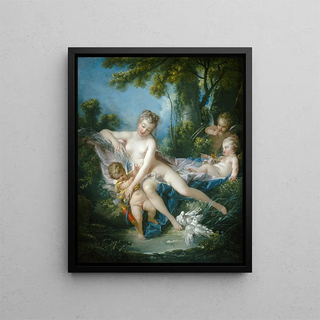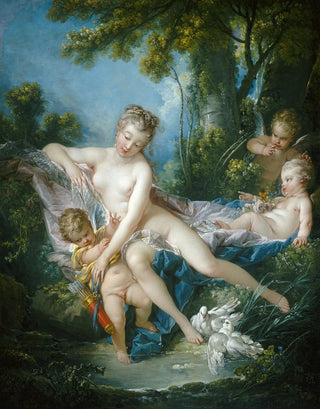Art print | The Bath of Venus - François Boucher


View from behind

Frame (optional)
In the vibrant universe of Rococo, "The Bath of Venus" by François Boucher stands out as an iconic artwork, where sensuality and beauty blend in perfect harmony. This canvas, painted in the 18th century, immerses the viewer in a world of delights and elegance, where the goddess of love reveals herself in all her splendor. The delicate nuances and refined compositions of Boucher capture not only the essence of mythology but also the spirit of an era when art reflected the pleasures of life. Gazing upon this piece, one is immediately transported to a dream garden, where nature and the divine intertwine gracefully.
Style and uniqueness of the artwork
François Boucher's style is characterized by a lightness and fluidity that seem almost tangible. "The Bath of Venus" perfectly illustrates this approach, with its pastel colors, curved forms, and meticulous details. The composition is dynamic, with each element carefully orchestrated to guide the eye toward the central figure of Venus. The goddess, surrounded by nymphs, is depicted in a moment of pure intimacy, evoking both beauty and vulnerability. The play of light and shadow, along with the richness of textures, gives this work depth and dimension that transcend the simple painting. Boucher manages to capture a fleeting instant, a pause in time, where the ephemeral becomes eternal.
The artist and his influence
François Boucher, one of the most influential artists of his time, left a mark on art history with his unique style and his ability to translate the desires and aspirations of 18th-century French society. Trained at the Royal Academy of Painting and Sculpture, he quickly established himself as the favorite painter of Louis XV's court. His work goes far beyond mere representation; it embodies a vision of the world where pleasure, beauty, and sensuality are celebrated. Through "The Bath of Venus," Boucher does not merely depict a mythological scene; he creates an universe where every detail, every color, and every

Matte finish

View from behind

Frame (optional)
In the vibrant universe of Rococo, "The Bath of Venus" by François Boucher stands out as an iconic artwork, where sensuality and beauty blend in perfect harmony. This canvas, painted in the 18th century, immerses the viewer in a world of delights and elegance, where the goddess of love reveals herself in all her splendor. The delicate nuances and refined compositions of Boucher capture not only the essence of mythology but also the spirit of an era when art reflected the pleasures of life. Gazing upon this piece, one is immediately transported to a dream garden, where nature and the divine intertwine gracefully.
Style and uniqueness of the artwork
François Boucher's style is characterized by a lightness and fluidity that seem almost tangible. "The Bath of Venus" perfectly illustrates this approach, with its pastel colors, curved forms, and meticulous details. The composition is dynamic, with each element carefully orchestrated to guide the eye toward the central figure of Venus. The goddess, surrounded by nymphs, is depicted in a moment of pure intimacy, evoking both beauty and vulnerability. The play of light and shadow, along with the richness of textures, gives this work depth and dimension that transcend the simple painting. Boucher manages to capture a fleeting instant, a pause in time, where the ephemeral becomes eternal.
The artist and his influence
François Boucher, one of the most influential artists of his time, left a mark on art history with his unique style and his ability to translate the desires and aspirations of 18th-century French society. Trained at the Royal Academy of Painting and Sculpture, he quickly established himself as the favorite painter of Louis XV's court. His work goes far beyond mere representation; it embodies a vision of the world where pleasure, beauty, and sensuality are celebrated. Through "The Bath of Venus," Boucher does not merely depict a mythological scene; he creates an universe where every detail, every color, and every






